You can still get a V6 engine in Toyota’s Camry, which is the only remaining mid-sized/family-priced sedan that offers more than a four. Engines larger than that have become a rarity – in a class of cars where V6s were common as recently as five years ago.
Those who follow this heretical column know why this has happened.
The government’s continual ratcheting up of federal fuel economy mandatory minimums (CAFE) and “greenhouse gas emissions” regulations have made it very difficult – very expensive – to put more than fours in most cars, even ones that cost a lot more than a mid-sized family car like a Camry does. If you shop around the mid-sized luxury sedan class, you’ll see that even in that class, V6s are becoming both rare and very expensive.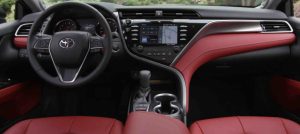
So, it’s really good news – if you want more than just a four – that the Camry still offers that option.
But probably not for much longer. The current model is going on five years old – so a makeover is likely coming next year or the year after.
After which, the Camry may no longer be available with more than a four – just like all the others in this class.
The Camry is Toyota’s mid-sized/family-priced sedan, similar to others in the class like its main rival, the Honda Accord – as well as the Mazda6, Hyundai Sonata and Kia K5.
It differs from all of them in that none of them are even available with more than a four, anymore. The Mazda6 soon won’t be available, at all. It’s been cancelled due to lack of interest – perhaps because it no longer offers more than a four.
The Camry also offers something else that’s remarkably rare in this class, all-wheel-drive.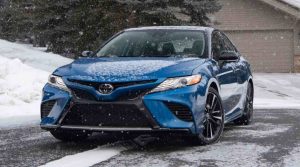
Just not with the V6.
Prices start at $25,845 for the base LE trim, which comes standard with a 203 horsepower four cylinder engine; AWD is available optionally. So equipped, the price rises to $27,245.
From there you can select from SE, SE Nightshade, XLE and XSE trims – all of which come standard with the same four and the option to get AWD. You can also option the XLE and XSE trims with a 301 horsepower V6, which bumps the price up to $35,070 and $35,620 respectively.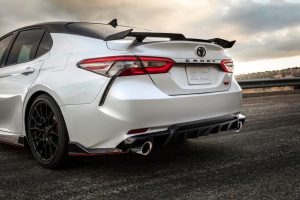
There is also a way to get the V6 for a bit less – along with some more of other things to go along with it. The TRD trim, which stickers for $32,910, comes standard with the V6 and a more aggressive look, to go along with it. It also has a firmer-riding suspension, sport-tuned exhaust, a rear decklid spoiler and red seatbelts.
What’s New For 2022
This year is a carryover year for the Camry and possibly the last year for the current model before the next major makeover.
Offers a V6; rivals don’t.
Standard four makes more than 200 horsepower, without a turbo.
Minimally invasive “driver assistance technology.”
What’s Not So Good
TRD version doesn’t get a more powerful version of the V6.
Rival Kia K5 starts out about $2k less to start ($23,790).
Rival Accord has a roomier back seat.
It’s not just the availability of a V6 engine that makes the Camry unusual – unique – in its class. It is also that its standard four cylinder engine isn’t turbocharged, as the smaller fours that come standard in rivals like the Accord and Kia K5 are.
Which they need to be, in order to make up for the fact that they are more than just smaller.
They are tiny.
The Accord’s standard four displaces just 1.5 liters; the Kia K5’s just 1.6 liters. There are motorcycle engines that are bigger than they are. In contrast, the Camry’s four displaces 2.5 liters, a size more appropriate for a car.
In particular, a mid-sized family car.
Interestingly, the Camry’s four not only makes more horsepower without relying on a turbocharger to boost its output, it also delivers the same or better gas mileage than its smaller-engined, turbo-boosted rivals.
You get 203 horsepower – and 28 city, 39 highway – as opposed to 192 horsepower and 30 city, 38 highway from the Accord. The Kia’s standard (and turbocharged) 1.6 liter four only manages 180 horsepower – 23 less than the Camry’s four – and only gets you 29 miles down the road in city driving and 38 on the highway.
So there’s no fuel-efficiency benefit to be had from these smaller, less powerful engines. But there could be a very big benefit to not having a smaller, turbo-boosted engine.
That being engine longevity.
The Accord and K5 engines are under a lot of pressure, literally. The turbo boost imparts stress to internal parts such as bearing surfaces, which are also smaller in smaller engines, so the load they must bear isn’t distributed over a larger area. Turbo’d engines also run hotter, which works the cooling system (including the oil) harder.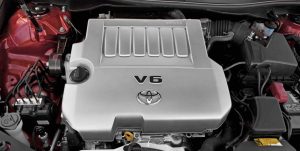
Plus, there is the turbo, itself – an expensive part that may have to be replaced at some point down the line. The Camry’s four is under less pressure. Its bearing surfaces are also larger, so they have more area to absorb the lighter loads placed upon them. This is the recipe for longevity. And you will never have to worry about the expense of replacing a cooked turbo.
Then there’s the Camry’s available V6, 3.5 liters and 302 horsepower. This engine completely outclasses the Accord’s optional (2.0 liter) four, which only makes 252 horsepower. The Kia K5’s optional 2.5 liter four comes closer, offering 290 horsepower. But in order for this small engine to post a big number, it also requires boost – and the pressure that comes along with it.
Maybe it won’t affect longevity. But it’s established fact that the Toyota 3.5 V6 is one of the most long-lived (and reliable) engines ever put under the hood of a car. The Honda Accord used to have an equally brilliant V6, too.
It’s a shame it longer does.
And: Both of the Camrys engines are regular fuel (87 octane) engines. Turbo’d engines often need premium to produce their advertised horsepower. It’s a kind of horsepower tax you pay at every fill-up.
An eight speed automatic transmission is standard with either of the Camry’s two available engines – and the four is available with all-wheel-drive, giving the Camry another desirable feature availability that isn’t available with the Accord, which is front-drive-only. The Kia K5 is available with AWD – with its standard (1.6 liter) four cylinder engine. Like the Camry, it does not offer AWD with its optional (2.5 liter) engine.
V6-powered Camrys are front-drive-only, too.
How far have we come? One way to measure that is to ask – how fast does it go?
Equipped with its available V6, the Camry is capable of getting to 60 MPH in just over five seconds and through the quarter mile in the high 13s. These are quicker times than those posted by V8-powered muscle cars like the Ford Mustang GT as recently as the early 2000s – and much quicker times than most V8 muscle cars of the ’60s posted.
None of them got 33 MPG on the highway, either.
And it does it with a 2.56 final drive ratio. Most muscle cars had 3.23 (or greater) ratios, to get them going quickly. It also had them guzzling a lot, quickly.
The Camry doesn’t. Remember: This is a family sedan, not a muscle car. It does not idle roughly or tend to overheat, as muscle cars often did. It is easy to drive, too – as muscle cars generally weren’t.
It’s a pussycat, in fact – until you ask it to roar.
The four isn’t far behind, either. It gets the Camry to 60 in about 6.6 seconds, which (again) would have been regarded as a very respectable time for a V8 muscle car, back in the days of the V8 muscle car. The almost 40 MPG you get on the highway is easily twice what V8 powered muscle cars managed, too.
We have, indeed, come a long way.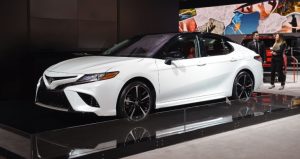
It’s just a shame that it’s all going away. Toyota is the last holdout. The last major automaker to not have given up on big engines in mid-sized family cars . . . and that hasn’t turbocharged very small engines, to make up for their tiny size. Probably because Toyota knows its buyers esteem the proven track record of reliability and durability established by its V6 and no-turbo four cylinder engines – and that trying to sell them lesser engines (literally) that offer no tangible fuel efficiency or power benefit that may not be reliable or durable after the warranty runs out is not sound policy.
Besides: Without that V6 – and with a turbo’d four – the Camry becomes just another car in this class, rather than the only car of its kind in the class.
One of the Camry’s greatest virtues is its quiet looks. It does not look like the muscle car-killer it is – or can be, if the mood strikes. It is the kind of car that does not draw attention to itself – unless you want to draw attention to yourself.
In that case, there is the TRD version of the Camry.
TRD being the acronym for Toyota Racing Development.
This version of the Camry looks a lot like the version of the Camry you can see on the track at Nextel Cup races. That Camry has a V8 – and is rear-wheel-drive. But the visuals – and the attitude – are not dissimilar. It sits lower than other Camrys – and it has a chin spoiler and rear-decklid wing to further make that ready-to-roll statement.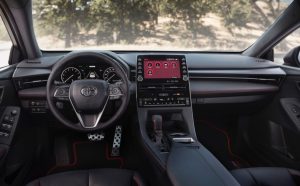
Oddly, there’s no additional go to back up the additional show. The TRD iteration of the Camry comes with the same V6 that’s optional in the more demure-looking XLE and XSE iterations – although it does sound tougher, on account of a less-muffled exhaust. And there is a lot of potential for more go locked up within that V6.
But it’ll be up to you to unlock it.
All Camrys come with ample room in front and back – an important consideration for a family car. There’s 42 inches of legroom for the driver and front seat passenger and 38 inches for those in back.
The Accord has a little more room in back (40.4 inches) but it’s not a big enough difference to make all that much difference. There is, however, a lot of difference vs. the Kia K5, which has the most legroom up front of the bunch (an astounding 46.1 inches) but that comes at the cost of a significantly less roomy back seat (35.2 inches of legroom) than the Camry and Accord offer.
The Camry’s 15.1 cubic foot trunk splits the difference between the Accord’s class-biggest 16.7 cubic footer and the Kia’s 16 cubic-footer.
The Rest
All Camry trims come with a package of “driver assistance technology,” including Lane Keep Assist and Braking Assist – but the systems aren’t as peremptory as is often the case in other cars. All trims also come standard with adaptive cruise control, which is a useful feature that’s nice to have – especially since Toyota doesn’t make you buy a more expensive trim in order to have it.
If, however, you’d like to have heated seats and wireless charging, you’ll have to step up to the XLE or XSE trims.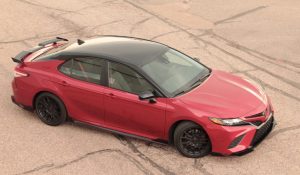
Interestingly, the TRD trim – which is the only Camry that comes standard with the V6 – costs several thousand dollars less than the XLE and XSE trims when optioned with the V6 ($35,720 and $36,270 respectively – vs. $32,910 for the TRD).
But if you’d like the go without the show . . .
The Bottom Line
Family cars like the Camry were once as prolific as dandelions after a summer downpour. Now the Camry’s the only bloom left, after the deluge.
. . .
Got a question about cars, Libertarian politics – or anything else? Click on the “ask Eric” link and send ’em in! Or email me at [email protected] if the @!** “ask Eric” button doesn’t work!
If you like what you’ve found here please consider supporting EPautos.
We depend on you to keep the wheels turning!
Our donate button is here.
If you prefer not to use PayPal, our mailing address is:
EPautos
721 Hummingbird Lane SE
Copper Hill, VA 24079
PS: Get an EPautos magnet or sticker or coaster in return for a $20 or more one-time donation or a $10 or more monthly recurring donation. (Please be sure to tell us you want a magnet or sticker or coaster – and also, provide an address, so we know where to mail the thing!)
My eBook about car buying (new and used) is also available for your favorite price – free! Click here. If that fails, email me at [email protected] and I will send you a copy directly!


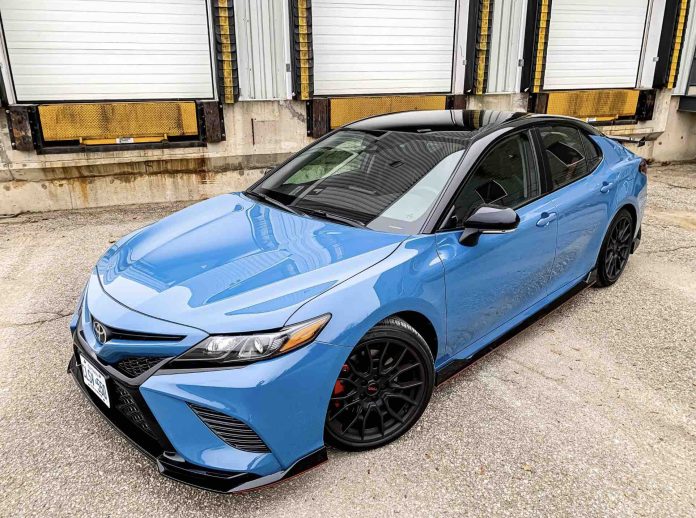

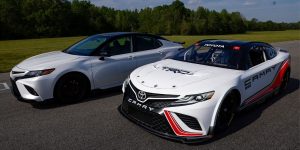

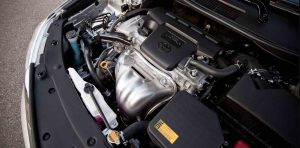
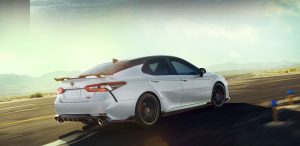










Kia is not even in the ballpark to be a Toyota alternative.
God bless Toyota for resisting the trend to total acquiescence to the state. Though acquiescent they are. They have little choice.
203 horsepower, from a 2.5 four, naturally aspirated? Is that not what made the Honda Prelude the sensation that it was? And more horsepower than V8s had 30 years ago? If, and it’s very iffy, I was interested in a new car, I would buy one in a heartbeat.
I really liked these when I first saw them a few years ago. Now, I see them very often and my opinion has changed. Sort of like a PT cruiser. They were cool until they were common.
Hi Ben,
I once felt that way about Mustang LX 5.0s back in the ’80s; they were everywhere. Now I wish I had one!
Hello, Eric, I just bought a 2022 Camry, SE (all-wheel drive) in March, as my old, WRX (a 2006) has 234,000 miles, is old, and is now semi-retired. But, I cannot bear to get rid of it, as it will make a good, back-up vehicle. My (automatic trans) Camry came with a “Standard Mode”, which I like. After driving my old, 2006 WRX (a standard), I am still fishing for the clutch pedal-ha ha. This one definitely is more “road trip” worthy (and is way more comfortable) than my (racer car seat) WRX, and it definitely gets better gas mileage, as well. My WRX is more “shot-out-of-a-cannon” worthy than the Camry, but this Camry has the muscle, too, I am just learning to work with it. It does have the heated seats and heated steering wheel: A definite must with having nine months of -40 below Winter. It has way more leg room than the WRX, and has more trunk space for my warm-weather gear, as well. I was breathing a sigh of relief, that I was able to get snow tires, as with the supply chain breaking down, I was not sure if they were going to arrive in time. I DO miss having the old fashioned, CD player, but got an Android (and Spotify) for the music. However, I am keeping the WRX for a back-up, as I do not figure this thing will go anywhere if an EMP type event came along. As nice as this Camry is, it will not go anywhere, I do not anticipate, with all the electronics (ugh). I might have a chance in hell of going somewhere with my old, WRX in that case? Oh, and it has a sun roof, too. Hmm, maybe I can catch the Auroras during the Winter through that? I did not need one of those, but hey, I got it, so I take the “Life is short, may as well enjoy it” view. I admit it was nice not having car payments for 13 years, and now did not seem like the time to have them (and thus, also another reason to keep the WRX), but will enjoy the Camry while I have it. All-in-all, it is a nice ride, and nice vehicle. Oh, and I do not have to crawl out of it (ha ha) the way I do the WRX. The guy who sold me the vehicle shut off all the “saaaaaftey” crap, and I have had no problems with any of that junk since I drove it off the lot. For as the old saying goes, “good riddance to bad rubbish” to that!
Hi Shadow,
Good stuff! A friend of mine – who has a 4th generation Trans-Am – got a Camry on my advice because he needed a more practical car to haul his daughter around in. I told him the V6 Camry was just as quick as his TA, but a lot more under-the-radar. So he could “get away” with using it more than his loud black Trans-Am. He almost never drives his TA anymore…
Shadow,
“After driving my old, 2006 WRX (a standard), I am still fishing for the clutch pedal-ha ha.”
My major malfunction going from decades of driving a manual, and changing to an auto, has been turning it off, leaving it “in gear” and bailing out of it, and jumping back in to keep it from rolling away. If I was still able to drive a manual, I would still be driving one. Getting old sucks.
Yeah, it does bite the big one, John-getting old, that is. I remember an old guy lamenting to me once, “it’s hell getting old”. Just the way he said it cracked me up. I told him it was a chronic thing, and was going to happen to all of us. But yeah, the first time I got out of the Camry, I left it in “drive” when I shut the engine off, and then wondered why something was “off”. I felt really stupid when I figured it out, but after having the standard for so long, I did not have to worry too much about the gears, so long as I had the hand brake set. Oh yeah, and the gas tank is on the opposite side of the WRX, so after work one day, and being really tired, I drove to the station on the wrong side. Yeah, it is definitely a re-learning experience on a lot of levels.
I bought for cash in December at MSRP a base level 2022 Camry based upon Eric’s 2021 review and Scotty. No stick after 2021.
The appliance automobile is pleasant enough with good visibility and all of the comprehensive standard trim. I wanted the higher profile tires and a key start with no ASS and lane junk. They have that hideous maw of the front but a very dark silver does not accent the horrid grille.
The thing is at the end of the model design which means that they refined and fixed just about any previous faults. The four 2.5L is no racer but it is good for what the car was made to do. The fuel consumption with my driving style makes the claims true, which is rare. I drive far less than 10k/year, so it should last far longer than I will be alive.
The dealer put the optional floor mats in it and wanted to fight if I insisted on removing them from the invoice, so I paid for them. They are difficult to get now at MSRP and base level.
I would never have considered this car had not I read Eric’s previous review. The dealer was uninterested why I bought the car. Too bad that Eric gets no feedback on his generated sales.
Hi Eric
Test drive one of these
Donkervoort’s Insane Hot Rods Are Finally Coming to the US….$240,000
The only production car in the world that will corner at over 2G’s
The quickest car sold in Europe
https://robbreport.com/…/donkervoort-sell-cars-in-us…/
Super 7 the best driver’s car, the ultimate driving experience….
Donkervoort a Super 7 clone:
The Best Seven-Based Track Car?
Audi Powered Donkervoort GTO RS …….. Dutch sports car that can pull over 2G’s in corners, no other street legal car can do that, the quickest car sold in europe…..
No driver assists only Traction control, fully analog you have to drive the car….
A super 7 (a 1957 design by Lotus), is the ultimate driving experience, buy or test drive one, it is a completely different experience. The most direct, analog, raw, visceral, unfiltered driving experience, perfect for the hard core driver enthusiasts, this is how a car should be, small, light, agile, fast, no frills, mechanical art made to go fast only, no luxury, no doors or roof, some have no windshield, nothing extra, with a 4 cylinder engine about 1200 lb.
https://www.youtube.com/watch?v=rl3lmCcBSqY
link
https://robbreport.com/motors/cars/donkervoort-sell-cars-in-us-1234727223/
I think the lack of V6’s in mid size cars is another reason people don’t buy them anymore. Had a Honda Accord with the 4 cylinder and it is under engined in my opinion, and that one had a much bigger 4 cylinder engine (2 liter something vs the 1 liter now) than the current offering.
But I grew up on V8’s and their seemingly effortless power. So it’s what I like. My driving habits don’t result in good mileage with tiny engines anyway, so why bother with one anyway. I would like to put a V8 Charger in my garage before they go away, it’s probably the only car I would even consider. So when it goes away, its likely full size pickups and SUV’s will be what I drive, though V8’s are going away fast in those now too.
Read today that the Chevy Colorado mid size pickup is out of diesel engines for the rest of the 2022 model year. Since it’s getting redesigned for 2023, that means no more gas V6 or diesel engines anymore as the 4 cylinder will be the only powertrain offered in the new model. Guessing there is a lame electric version planned for later.
I have RAV 4 with the 3.5 V6,and have to say it’s legitimately fast. This is coming from someone who has had fast/muscle cars their entire life.
It’s good on gas,and currently has 190k trouble-free miles on it. One of the best parts is that it uses a timing chain ,instead of a belt. Which is great ,if you keep your cars as long I do.
Rented a RAV 4 once (after the V6 was discontinued), it was nice, but it sure isn’t fast. It’s another vehicle now under engined thanks to uncle. Which is too bad. Now you HAVE to keep it if you want a RAV 4 with a V6.
Kudos for leaving the screen down in the dash instead of sticking up into the sight line of the windshield/dashboard! Seats look relatively flat too, a plus these days in the era of rallye style seats where the side bolsters eat into your thighs and shoulders.
I’ve always thought Camrys were nice looking cars. I just wish car makers would quit making the headrests so big and leaning forward so much. Do they want you looking at your knees? I usually have to adjust the seat to where it’s leaning a little further back than I like, to keep the angle of the headrest from bothering me.
Thankfully, the Lane Assist in the Camry can be turned off and the Braking Assist sensitivity dialed down to a level where it will rarely engage. However, the long term concern I have with my 2018 Camry is the $1200 (the cost from Toyota) forward-facing camera which feeds the optical-based “saaaafety” systems that I don’t use. I’ve had the camera fail twice for about five minutes each time, and the dash lights up like a Christmas tree to the point where I doubt it would pass inspection here in Texas.
Note: The Braking Assist sensitivity can be dialed down but not turned off without another light appearing on the dash.
Beyond that, the car has been mostly OK, but the 8 speed transmission in the 2018 is … weird … for lack of a better term, and the emergency brake requires a LOT of pressure on the pedal to engage properly.
BTW, my Camry doesn’t have A.S.S. but I believe Toyota snuck it into later model years.
I was hesitant to buy the 2018, but I didn’t want start/stop which was rumored for the 2019s.
I did a double-take when I spotted a TRD Camry on the way to work. Sharp looking car. Nothing “family sedan” about it other than four doors. And prety much everything out there has four doors, so that’s really not a minus.